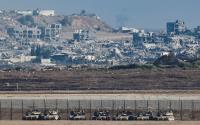26 July 2007Commons Dreams
Last week, a media advisory from “The NewsHour with Jim Lehrer” announced a new series of interviews on the PBS show that will address “what Iraq might look like when the U.S. military leaves.”
A few days later, Time magazine published a cover story titled “Iraq: What will happen when we leave.”
But it turns out, what will happen when we leave is that we won’t leave.
Urging a course of action that’s now supported by “the best strategic minds in both parties,” the Time story calls for “an orderly withdrawal of about half the 160,000 troops currently in Iraq by the middle of 2008.” And: “A force of 50,000 to 100,000 troops would dig in for a longer stay to protect America’s most vital interests…”
On Iraq policy, in Washington, the differences between Republicans and Democrats — and between the media’s war boosters and opponents — are often significant. Yet they’re apt to mask the emergence of a general formula that could gain wide support from the political and media establishment.
The formula’s details and timelines are up for grabs. But there’s not a single “major” candidate for president willing to call for withdrawal of all U.S. forces — not just “combat” troops — from Iraq, or willing to call for a complete halt to U.S. bombing of that country.
Those candidates know that powerful elites in this country just don’t want to give up the leverage of an ongoing U.S. military presence in Iraq, with its enormous reserves of oil and geopolitical value. It’s a good bet that American media and political powerhouses would fix the wagon of any presidential campaign that truly advocated an end to the U.S. war in — and on — Iraq.
The disconnect between public opinion and elite opinion has led to reverse perceptions of a crisis of democracy. As war continues, some are appalled at the absence of democracy while others are frightened by the potential of it. From the grassroots, the scarcity of democracy is transparent and outrageous. For elites, unleashed democracy could jeopardize the priorities of the military-industrial-media complex.
Converging powerful forces in Washington — eager to at least superficially bridge the gap between grassroots and elite priorities — are likely to come up with a game plan for withdrawing from Iraq without withdrawing from Iraq.
Scratch the surface of current media scenarios for a U.S. pullout from Iraq, and you’re left with little more than speculation — fueled by giant dollops of political manipulation. In fact, strategic leaks and un-attributed claims about U.S. plans for withdrawal have emerged periodically to release some steam from domestic antiwar pressures.
Nearly three years ago — with discontent over the war threatening to undermine President Bush’s prospects for a second term — the White House ally Robert Novak floated a rosy scenario in his nationally syndicated column that appeared on Sept. 20, 2004. “Inside the Bush administration policy-making apparatus, there is strong feeling that U.S. troops must leave Iraq next year,” he wrote. “This determination is not predicated on success in implanting Iraqi democracy and internal stability. Rather, the officials are saying: Ready or not, here we go.”
Novak’s column went on to tell readers: “Well-placed sources in the administration are confident Bush’s decision will be to get out.” Those well-placed sources were, of course, unnamed. And for good measure, Novak followed up a month before the November 2004 election with a piece that recycled the gist of his Sept. 20 column and chortled: “Nobody from the administration has officially rejected my column.”
This is all relevant history today as news media are spinning out umpteen scenarios for U.S. withdrawal from Iraq. The game involves dangling illusionary references to “withdrawal” in front of the public.
But realities on the ground — and in the air — are quite different. A recent news dispatch from an air base in Iraq, by Charles J. Hanley of the Associated Press, provided a rare look at the high-tech escalation underway. “Away from the headlines and debate over the ’surge’ in U.S. ground troops,” AP reported on July 14, “the Air Force has quietly built up its hardware inside Iraq, sharply stepped up bombing and laid a foundation for a sustained air campaign in support of American and Iraqi forces.”
In contrast to the spun speculation so popular with U.S. media outlets like Time and the PBS “NewsHour,” the AP article cited key information: “Squadrons of attack planes have been added to the in-country fleet. The air reconnaissance arm has almost doubled since last year. The powerful B1-B bomber has been recalled to action over Iraq.”
This kind of development fits a historic pattern — one that had horrific consequences during the war in Vietnam and, unless stopped, will persist for many years to come in Iraq.
Assessing the distant mirror of the Vietnam War, the narration of the new documentary “War Made Easy” (based on my book of the same name) spells out a classic White House maneuver: “Even when calls for withdrawal have eventually become too loud to ignore, officials have put forward strategies for ending war that have had the effect of prolonging it — in some cases, as with the Nixon administration’s strategy of Vietnamization, actually escalating war in the name of ending it.”
Between mid-1969 and mid-1972, American troop levels dropped sharply in Vietnam — while the deadly ferocity of American bombing spiked upward.
The presence of large numbers of U.S. troops in Iraq during the next years is a likelihood fogged up by fanciful media stories asserting — without tangible evidence — that American troops will “pull out” and the U.S. military will “leave” Iraq. The spin routinely glides past such matters as the hugely militarized U.S. embassy in Baghdad, the numerous permanent-mode U.S. bases in Iraq, and the vast array of private-and-often-paramilitary contractors at work there courtesy of U.S. taxpayers. And there’s the rarely mentioned prize of massive oil reserves that top officials in Washington keep their eyes on.
The matter of U.S. bases in Iraq is a prime example of how events on Capitol Hill have scant effects on war machinery in the context of out-of-control presidential power. “The House voted overwhelmingly on Wednesday to bar permanent United States military bases in Iraq,” the New York Times reports. But the war makers in the nation’s capital still hold the whip that keeps lashing the dogs of war.
As the insightful analyst Phyllis Bennis points out: “The bill states an important principle opposing the ‘establishment’ of new bases in Iraq and ‘not to exercise United States control of the oil resources of Iraq.’ But it is limited in several ways. It prohibits only those bases which are acknowledged to be for the purpose of permanently stationing U.S. troops in Iraq; therefore any base constructed for temporarily stationing troops, or rotating troops, or anything less than an officially permanent deployment, would still be accepted. Further, the bill says nothing about the need to decommission the existing U.S. bases already built in Iraq; it only prohibits ‘establishing’ military installations, implying only new ones would be prohibited.”
Despite all the talk about how members of Congress have been turning against the war, few are clearly advocating a genuine end to U.S. military intervention in Iraq. Media outlets will keep telling us that the U.S. government is developing serious plans to “leave” Iraq. But we would be foolish to believe those tall tales. The antiwar movement has an enormous amount of grassroots work to do — changing the political terrain of the United States from the bottom up — before the calculus of political opportunism in Washington determines that it would be more expedient to end the U.S. occupation of Iraq than to keep it going under one guise or another.
The new documentary film “War Made Easy: How Presidents and Pundits Keep Spinning Us to Death” is based on Norman Solomon’s book of the same title. Grassroots groups have begun to show the DVD around the country.For information about the full-length movie, produced by the Media Education Foundation and narrated by Sean Penn, go here. http://www.theconnextion.com/index.cfm?ArtistID=422&NoFrame=Yes&RefID=10






